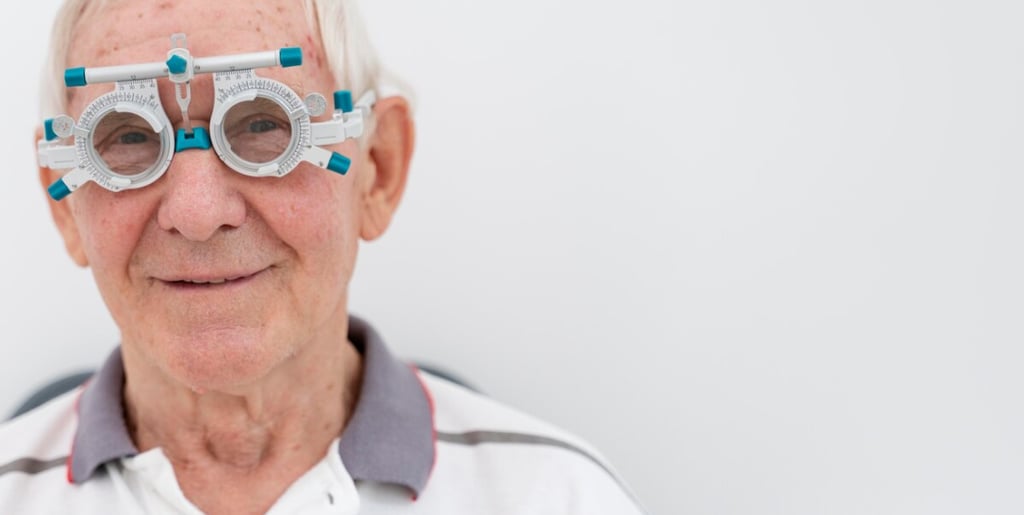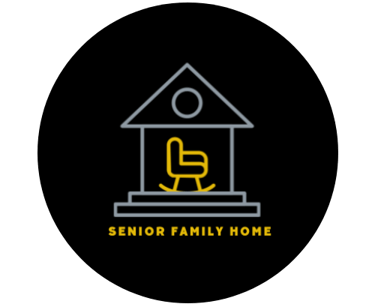Aging and Your Eyes: What Seniors and RCFE Caregivers Need to Know


Our eyes are remarkable—and, as with any finely tuned instrument, they require extra care as the years go by. Whether you’re a senior living in a Residential Care Facility for the Elderly (RCFE) or a caregiver supporting someone who is, understanding age-related vision changes—and how to manage them—can make all the difference in comfort, safety, and quality of life.
1. Presbyopia: When Close-Up Tasks Become a Struggle
Around the early to mid-forties, many seniors notice that reading labels, menus, or medication instructions takes more effort. This normal change—known as presbyopia—occurs when the eye’s lens loses flexibility, making it harder to switch focus to nearby objects.
Practical Tip for Caregivers: Keep a selection of over-the-counter reading glasses (ranging from +1.00 to +3.00 power) in communal areas—libraries, activity rooms, or bedside tables—so seniors always have easy access.
Extra Comfort: Offer lightweight, spring-hinged frames that stay comfortably in place during arts & crafts or mealtimes.
Quick Note: Labeling glasses with their magnification strength helps residents pick the right pair at a glance.
2. Smaller Pupils and Light Sensitivity
As we age, pupils tend to shrink and adjust more slowly to changes in light. Stepping from bright sunlight into a dim hallway can feel temporarily disorienting—an issue that may increase fall risk or make evening activities less enjoyable.
Facility Improvements: Install motion-activated, low-glare lighting along corridors and staircases. Use bulbs with a color temperature close to daylight (around 5000 K) to reduce eye strain.
Sunglass Corner: During outdoor strolls or garden visits, offer seniors polarized sunglasses with side shields to cut glare and protect against harmful UV rays.
Caregiver’s Insight: A well-lit environment isn’t just safer—it helps residents feel more confident moving around independently.
3. Cataracts: When Vision Feels Foggy
Cataracts develop when proteins in the eye’s lens clump together, scattering light and dulling colors—much like a frosted window. Symptoms often include increased glare, muted hues, and difficulty seeing in low light.
Supporting Appointments: Coordinate transportation and accompaniment for eye-care visits. Review pre-surgery instructions together to ease any anxiety.
Post-Surgery Care: After cataract removal, guide seniors through their medication schedule, and plan gentle activities—puzzles, audiobooks, or social games—while vision fully recovers.
A Caregiver’s Tip: Encourage social engagement during recovery; laughter and conversation can lift spirits faster than any medication.
4. Glaucoma: Protecting Peripheral Vision
Often symptom-free at first, glaucoma damages the optic nerve—commonly due to elevated eye pressure—and typically affects side vision before central sight. Early detection is crucial for slowing its progression.
On-Site Screenings: Partner with mobile or visiting eye-care clinics to offer regular pressure checks right at the facility.
Medication Management: Use pill organizers and reminder charts to ensure seniors apply prescribed eye drops consistently and correctly.
Reminder: Encourage open communication—if a resident feels eye discomfort or notices vision changes, prompt evaluation can make all the difference.
5. Age-Related Macular Degeneration (AMD): Guarding Central Vision
AMD targets the macula, the small area of the retina responsible for fine detail. Early signs include blurred or wavy lines, making tasks like reading or recognizing faces a challenge.
Nutrition Focus: Serve meals rich in leafy greens (spinach, kale), oily fish (salmon, mackerel), and colorful fruits (berries, oranges) full of antioxidants and healthy fats.
Lifestyle Support: Encourage smoking cessation programs and regular exercise—both shown to help slow AMD progression.
Did You Know? Simple Amsler grid exercises—reading a dotted grid chart—can be done weekly to spot new distortions early.
6. Dry Eyes: Soothing Irritation and Grittiness
Reduced tear production or changes in tear quality can lead to chronic dryness, burning, or a feeling of grit under the eyelids.
Environmental Controls: Maintain moderate humidity in common rooms and bedrooms to prevent air from becoming too dry.
Comfort Stations: Place preservative-free lubricating drops and warm compress kits in accessible areas—near reading chairs or TV lounges.
Pro Tip: Encourage residents to blink fully and frequently, especially during long activities like knitting or card games.
Daily Habits for Lifelong Eye Health
Annual Comprehensive Exams
Even without obvious symptoms, yearly check-ups can uncover glaucoma, AMD, or other issues early—when treatment is most effective.Balanced, Vision-Friendly Diet
Omega-3s, vitamins C and E, zinc, lutein, and zeaxanthin all support eye health. Consider incorporating fortified cereals or smoothies packed with these nutrients.Regular Physical Activity
From chair yoga to garden walks, gentle exercise boosts overall circulation, benefiting ocular health and reducing risks of diabetic retinopathy and glaucoma.UV Protection Every Day
Equip seniors with 100% UVA/UVB blocking sunglasses and encourage hat use during outdoor activities.The 20-20-20 Rule
For screen-based tasks (tablets for video calls, digital photo frames, e-readers), remind residents every 20 minutes to look at an object 20 feet away for 20 seconds—this simple break eases focusing muscle fatigue.
Empowering Caregivers and Families
RCFE caregivers play a vital role in supporting seniors’ vision:
Routine Checks: Observe for subtle signs—extra squinting, avoiding certain activities, reluctance to drive to appointments.
Environment Audits: Regularly assess lighting levels, contrast markings on steps, and clutter-free pathways.
Communication Tools: Use large-print schedules, high-contrast signage, and clear verbal instructions to reduce confusion.
Families can stay involved by:
Joining Visits: Accompanying loved ones to eye exams or specialist appointments.
Sharing Observations: Noting any changes at home—difficulty reading mail, increased screen time discomfort, or tearing up more often.
Supporting Lifestyle Choices: Encouraging nutritious meals, helping set up reading glasses in key areas, and reminding about protective eyewear.
Looking Ahead: Keeping Life in Focus
Aging naturally brings change, but needless vision loss doesn’t have to be one of them. With proactive exams, thoughtful environmental adjustments, balanced nutrition, and attentive caregiving, seniors and their RCFE support teams can maintain clear, comfortable vision—and keep every moment bright, sharp, and full of life.


